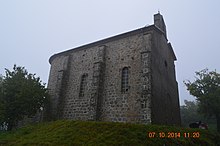Ajoux
Ajoux | |
|---|---|
 Ajoux Water Troughs | |
| Country | France |
| Region | Auvergne-Rhône-Alpes |
| Department | Ardèche |
| Arrondissement | Privas |
| Canton | Privas |
| Intercommunality | Roche de Gourdon |
| Government | |
| • Mayor (2008–2020) | Annick Rybus |
Area 1 | 12.2 km2 (4.7 sq mi) |
| Population (2010) | 95 |
| • Density | 7.8/km2 (20/sq mi) |
| Time zone | UTC+01:00 (CET) |
| • Summer (DST) | UTC+02:00 (CEST) |
| INSEE/Postal code | 07004 /07000 |
| Elevation | 393–1,068 m (1,289–3,504 ft) (avg. 750 m or 2,460 ft) |
| 1 French Land Register data, which excludes lakes, ponds, glaciers > 1 km2 (0.386 sq mi or 247 acres) and river estuaries. | |
Ajoux is a French commune in the Ardèche department in the Auvergne-Rhône-Alpes region of southern France.
The inhabitants of the commune are known as Ajouxois or Ajouxoises[1]
Geography
Ajoux is located some 100 km south by south east of Lyon and 100 km north by north-east of Avignon. The south of the commune is traversed by the D122 road which runs west from the D104 in a circuitous route through the commune then north-west to Mezilhac. It is possible to access the hamlet of Blaizac from this road via small mountain roads. The D361 runs off this road to the north through the commune to Ajoux village. It continues through the village to join the D244 within the commune. The D244 links La Pervenche in the north-west by a circuitous route through the commune and continues east passing near the hamlet of Mauves and joining the D344 near Pranles. The D261 follows the Auzene next to the northern border but does not link to the commune.
In addition to Ajoux, there are only the small hamlets of Blaizac and Mauves.
The northern border of the commune is delineated by the Auzene river and many streams flow from the commune north to join this river including the Auzener which forms the western border of the commune. The Auzene with many more tributaries downstream eventually joins the Eyneux river which eventually joins the Rhone at La Voulte-sur-Rhône.
The commune appears mountainous with forests and wasteland. There are two quarries but no farming.[2]
Neighbouring communes and towns[2]
Administration

List of Successive Mayors of Ajoux[3]
| From | To | Name | Party | Position |
|---|---|---|---|---|
| 2001 | 2008 | Pascal Dumoulin | ||
| 2008 | 2020 | Annick Rybus |
(Not all data is known)
Demography
In 2010 the commune had 95 inhabitants. The evolution of the number of inhabitants is known through the population censuses conducted in the town since 1793. From the 21st century, a census of municipalities with fewer than 10,000 inhabitants is held every five years, unlike larger towns that have a sample survey every year.[Note 1]
Template:Table Population Town


Distribution of Age Groups


The population of the town is relatively young. The number of people above the age of 60 years (19.1%) is lower than the national rate (21.8%) and the departmental level (26.8%). Like the national and departmental allocations, the female population of the municipality is higher than the male population. Rate (53.2%) is higher than the national rate (51.9%).
Percentage Distribution of Age Groups in Ajoux and Ardèche Department in 2008
| Ajoux | Ajoux | Ardèche | Ardèche | |
|---|---|---|---|---|
| Age Range | Men | Women | Men | Women |
| 0 to 14 Years | 22.7 | 18.0 | 18.7 | 16.9 |
| 15 to 29 Years | 6.8 | 12.0 | 15.5 | 14.2 |
| 30 to 44 Years | 20.5 | 24.0 | 20.2 | 19.2 |
| 45 to 59 Years | 31.8 | 26.0 | 21.7 | 20.6 |
| 60 to 74 Years | 13.6 | 18.0 | 15.7 | 16.0 |
| 75 to 89 Years | 4.5 | 2.0 | 7.8 | 11.6 |
| 90 Years+ | 0.0 | 0.0 | 0.4 | 1.5 |
Sources:
- Evolution and Structure of the population of the Commune in 2008, INSEE.
- Results of the Census for Ardèche in 2008, INSEE.
Sites and Monuments
The best known is the Ajoux Rock.
(Not to be confused with the Roche d'Ajoux in the Rhône department)
See also
Notes and references
Notes
- ^ At the beginning of the 21st century, the methods of identification have been modified by law No. 2002-276 of 27 February 2002 [1], the so-called "law of local democracy" and in particular Title V "census operations" which allow, after a transitional period running from 2004 to 2008, the annual publication of the legal population of the different French administrative districts. For municipalities with a population greater than 10,000 inhabitants, a sample survey is conducted annually, the entire territory of these municipalities is taken into account at the end of the period of five years. The first "legal population" after 1999 under this new law came into force on 1 January 2009 and was based on the census of 2006.
References
External links
- Ajoux Official website Template:Fr icon
- Ajoux on the old IGN website Template:Fr icon
- Ajoux on Lion1906
- Ajoux on Google Maps
- Ajoux on Géoportail, National Geographic Institute (IGN) website Template:Fr icon
- Ajou on the 1750 Cassini Map
- Ajoux on the INSEE website Template:Fr icon
- INSEE Template:Fr icon

